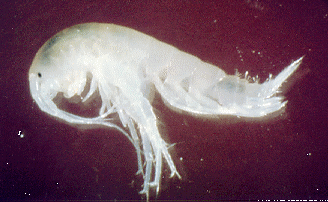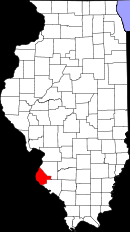 The problem
The problem
The Illinois Cave Amphipod isn’t the best known animal on the U.S Fish & Wildlife Service Endangered Species list. Species like the Gray Wolf and the Canada Lynx tend to get more press. But, as its name suggests, the Illinois Cave Amphipod is unique in that it can only be found in this state.
The Illinois Cave Amphipod Gammuras acherondytes is a crusatacaen—the subphylum that also includes shrimp, crabs, lobster, and crayfish. The species lives in caves in Monroe County, and formerly in St. Clair County, in the southwestern part of Illinois. All of these amphipods live within a ten mile radius of the city of Waterloo. The species is a less than an inch long and gray-blue in color. It is a scavenger that feeds on dead animals and plants.
Although the species is the prey of other non-human animals (the Cave Salamander for instance), the main threats to it come from people. The Illinois Cave Amphipod once could be found in six different cave systems; at the time it was placed on the Endangered Species list in 1998, it could only be found in three because of water pollution.
The cave streams it lives in have been polluted by agricultural chemicals, septic systems, and dumping—among other things.
 The region
The region
I spoke recently with UI Scientist Steve Taylor of the Illinois Natural History Survey, an expert on the Illinois Cave Amphipod.
He explained that, to make matters worse, the species is endemic to a scenic rural area being encroached by the expanding St. Louis metro area: “That area is desirable from a human standpoint because there’s rolling topography, with patches of woods, which in the Midwest—especially the Illinois side—is rare. There’s usually just lot of corn.”
The expanding human population means more water pollution and even more danger to these amphipods.
Moreover, because of topography of the region, pollutants get into the cave water even more quickly than they might in other types of land. Much of Monroe County is a karst region, which means it has lots of limestone. Rainwater—with the help of carbon dioxide from decaying vegetation—becomes acidic and eats through the limestone, forming sinkholes at the surface that drain into caves beneath it.
While in other types of regions rainwater and runoff is filtered before it reaches the aquifers beneath, in a karst region, water drains via sinkholes and can move very quickly into the underground streams below. These are the streams where the Illinois Amphipods live.
Taylor said, “If you release water that’s untreated, or improperly treated—like a leaking septic tank—there’s nowhere for that water to go but into the shallow karst aquifer, which means the cave system.”
It’s often hard to get people concerned about the problem, because the pollution is underground—out of sight and out of mind. Taylor said, “When we can’t see the problem, it’s a lot easier to ignore it. So, maybe fishermen see streams and lakes get polluted and they complain, but here you don’t see the effects.”
A lonely species
There probably were never all that many of this particular species to begin with.
The Illinois Cave Amphipod is a troglobite, an animal which can only survive in caves. At one time, its ancestors lived on the surface, went into the cave in search of better conditions, then stayed and became adapted over time to the extent that they became a new species. Unlike its surface ancestors, the Illinois Cave Amphipod has reduced and possibly non-functional eyes and is translucent in color. Eyes and pigmentation aren’t useful in the dark and take up energy to maintain. In the dark environment, where eyes and pigment afford little selective advantage, the species lost these traits over the generations.
Once it became adapted to these regional caves the species became isolated—restricted to its immediate area and had no way to spread to a wider range.
Federal protection
In 1998, the Illinois Cave Amphipod was listed as endangered by the U.S. Fish and Wildlife Service. Formerly, it was protected only by the state. The federal protection meant that it was now protected from changes in its habitat as well as simply from direct harm.
One argument for listing the species was the traditional one that any non-human animal needs to be protected from extinction just because that’s the right thing to do.
There were more practical arguments for protection as well. For instance, because it is highly sensitive to water pollution, the species has been described as a “canary in the coal mine” in that its health is indicative of the safety of the water supply. As Taylor put it when I spoke with him recently, “Do you want to live somewhere with a water supply that animals can’t live in?”
Not everyone was for giving the species federal protection. Farmers, in particular, were worried that their use of agricultural chemicals would be restricted. Also, there was some controversy as to how much the population of the species had dwindled in the first place. Furthermore, some cavers were worried that protecting the species might lead to shutting down some caves for recreational purposes.
Nevertheless, the plan went through. Farmers, developers, and others now have to follow federal rules if their activities threaten the species. For instance, Taylor gave this example of how the regulations might potentially affect people trying to build a road near the amphipod’s habitat: “You may need to make a storm water retention basin to prevent the water from going underground so quickly.”
Is the amphipod winning?
Along with the listing, an official recovery plan was written and signed. The goal is for the species to be recovered by 2023.
In the document, the main strategies of the recovery are listed as follows:
- Protect current populations and their habitats from known and suspected threats.
- Restore degraded habitat and reintroduce the species into historic habitats.
- Research basic biology and habitat requirements to increase the knowledge base about the species.
- Educate the public and provide technical assistance to local units of government and
planning agencies.
The recovery plan was put into effect in 2002. Funding—unsurprisingly—is a barrier to carrying out the many specific strategies described in the plan (for example, offering farmers financial incentives to create grassy or wooded areas around sinkholes to prevent runoff).
Taylor said, “We don’t have sufficient funding to really make huge progress, but that’s because of compromise. The public can’t say to the government—put all your money into the U.S. Fish and Wildlife Services. There are other demands in the world.”
One sign of progress is that the state has been buying up land where the amphipod lives in order to protect the area. Taylor said, “There have been some planned acquisitions that have been very positive, but there’s a ways to go.”
According to Taylor, it is difficult to quantify exactly how much—if any—the species has rebounded since it was listed as endangered . Although they are currently being implemented, the studies will take years, are expensive to fund, and their results are sometimes open to debate.
As far as the general trend, he said “I don’t think we have enough information to say exactly how things are going.”
On the whole, though, Taylor feels, “The goal is to down-list and delist the species. I think it’s a doable goal, but a difficult one. There are other endangered species, I think, for which recovery is just not possible—they will always be listed as endangered. For this species, I think it’s possible. It’s possible if we put sufficient resources towards it, if we educate people.”
While the plight of Illinois Cave Amphipod may seem to be of only local interest, Taylor sees the story as being symbolic of other environmental issues: “It’s a microcosm of all our other environmental issues. It’s really no different from polar bears, or logging in the Amazon. They’re all sort of the same thing on a philosophical level.”
As far as just how well the recovery plan is going so far, he said, “I’d give us a C. We’re definitely not getting an F in the class.”
He stated: “I wouldn’t say the amphipod is winning yet, but at least it hasn’t lost.”








